|
|
|
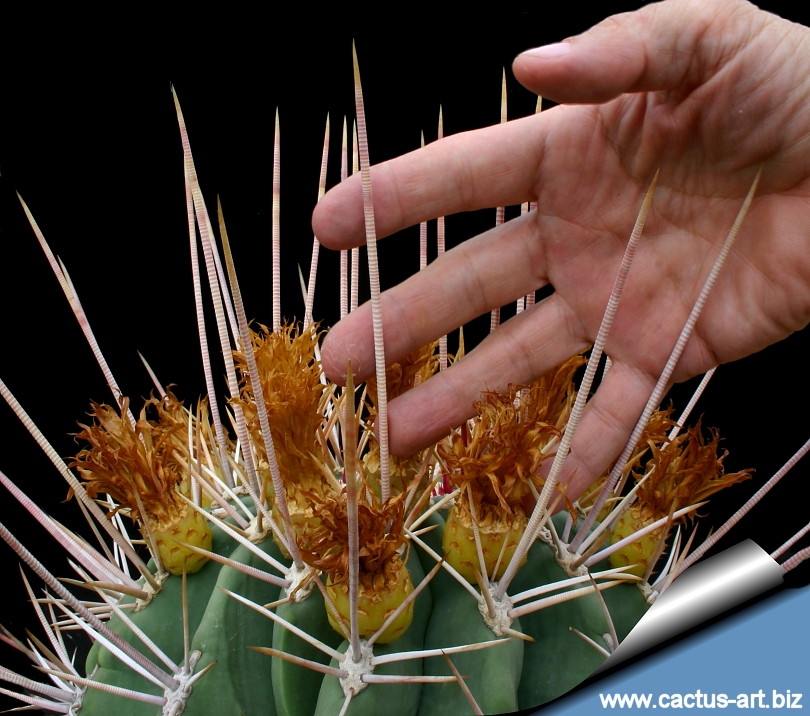
Ferocactus rectispinus (now considered Ferocactus emoryi ssp.
rectispinus)
This magnificent plant has some of the longest straightest
spines of the Ferocacti. In late summer it produces large yellow flowers
followed by lemon yellows persistent fruits.
|
|
Description: F. rectispinus is a
solitary barrel cactus except in case of injury to the growing tip.
Stems: Erect, globular when young to a stout cylinder when older,
30-200 tall × 30-60 cm in diameter; tubercled when young later forming
ribs.
Ribs: 15-21, shallowly notched immediately above each areole.
Areoles: Oval with brown wool, 3-4 cm apart.
Central spine: 1, very long ( 9-25 cm long × 2.5-4 mm. in cross
section ), never hooked (or slightly hooked, but only on relatively
young plants), roughly cylindrical, annulate, all robust and rigid.
Reddish, reddish grey, or horn coloured.
Radial spines: 5 to 9, spreading, not hooked, 2.5
to 7 cm long, with the upper 3 larger.
Flowers: Large, light yellow, 6-7.5 long× 5-7.5 cm in diameter:
Blooming season:
Summer.
Fruits: Persistent, oblong, scaled, 2,5-5cm long × 25-35 mm long
in diameter with the dried remains of the flower atop, ± readily
dehiscent through basal pore, bright yellow.
Seeds: 2 mm. in diameter, black.
|
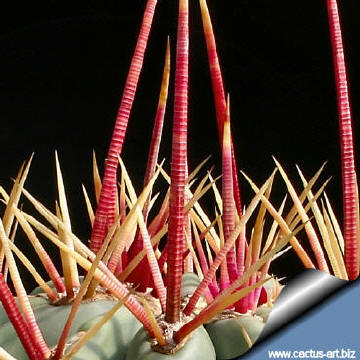
New spines are bright red. |
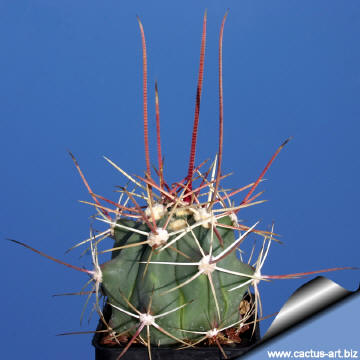
F. rectispinus SB1700 Cerro Colorado |
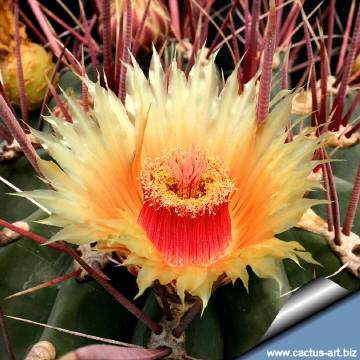 |
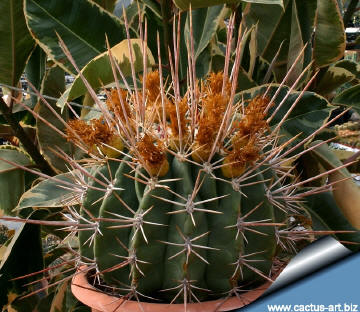
The long spined form from
Baja California. This species is easily recognized by its very long,
straight central spines and lack of bristly radials. |
|
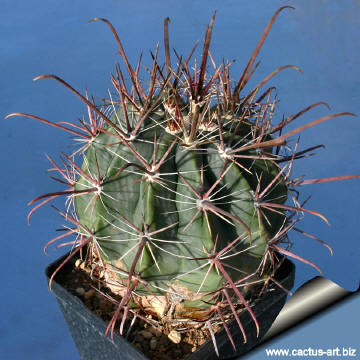
F. rectispinus from Bahía Conception |
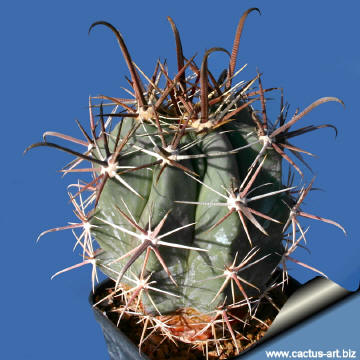
F. rectispinus from S. Ignazio |
|
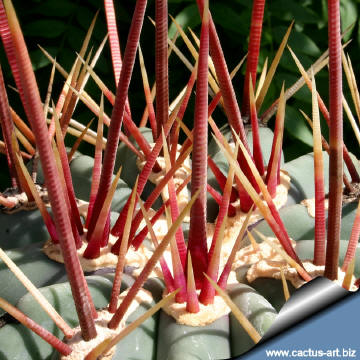 |
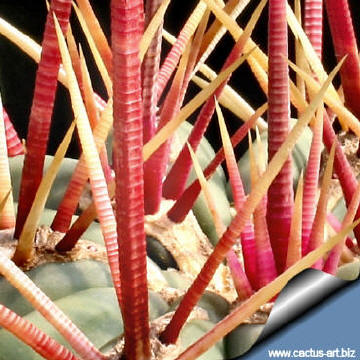 |
|
Spines are ridged never
hooked (in adult specimen) and almost
cylindrical.
The
central spine is very long (9-25 cm long) |
|
Photo of conspecific taxa, varieties, forms and cultivars of
F. emoryi.
|
|
Advertising
|
|
|
|
|
Family:
Cactaceae (Cactus
Family)
Accepted
Scientific Name: Ferocactus emoryi subsp. rectispinus (Engelm.) N. P. Taylor
Place of publication: Cactaceae Cons. Initiat. 6:16.
1998
Basyonim:
Common Names: Long Spined Barrel Cactus, Straight
Spine Barrel
Distribution:
(Central Baja California, Mexico)
Ferocactus rectispinus is a narrow endemic species, usually found near
the coast in the vicinity of Bahía de la Concepción. The Cerro Colorado
population is more inland and farther north than any previously
documented.
Habitat: Often on costal high cliffs.
Conservation status: Listed in
CITES appendix 2.
Synonyms:
- Ferocactus rectispinus
(Engelmann) Britton et Rose
Place of publication: Cact. 3:134, t. 142.
1922
- Ferocactus emoryi
(Engelmann) Orcutt 1926
- Echinocactus emoryi
[var.] rectispinus Engelmann 1896
- Ferocactus emory var.
rectispinus (Engelmann) N. P. Taylor 1984
|
|
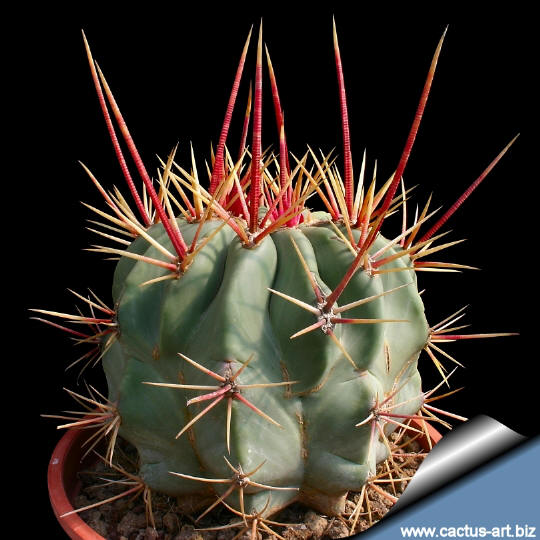
With lethally razor-sharp central spines up to 25 cm long, each of
them among the most fiercely armed of this generally fierce (“fero”
means fierce) genus.
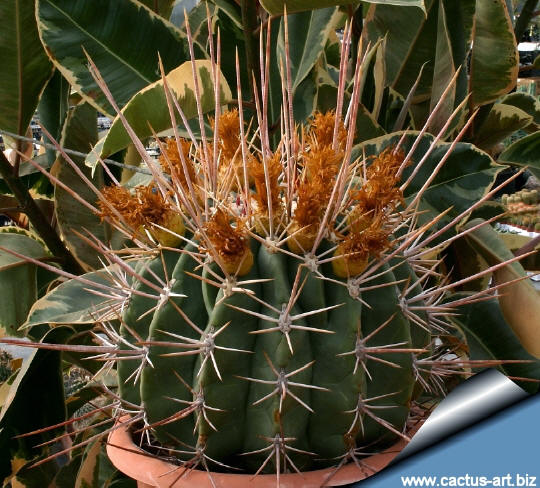
An extremely nice specimen of the long spined form from
Baja California. This species is easily recognized by its very long,
straight central spines and lack of bristly radials.
|
|
|
|
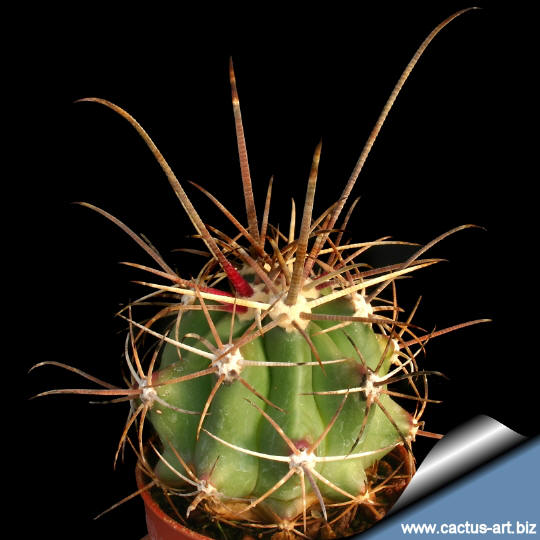
F. rectispinus SB1700 Cerro Colorado, South Baja California, Mexico
A young specimen with juvenile spines (slightly bent or hooked)
F.
rectispinus produce
nectar in the
nectaries at the top of the cactus that feed the
ants that live around its
base. In turn, the ants are very territorial and seem to protect
the plants from other
insects that might try to walk up the
stem and damage the fresh, delicate cells at the growing
apex or steal
nectar or
pollen from the flowers. This strategy is useful to not only to
protect the plant from small
herbivores but also to promote outcrossing pollination because
the only bugs that can successfully visit the flowers without being
attacked by the ants are flying
pollinator insects like butterflies and bees that carry pollen
from other individuals and other
populations, in turn increasing the genetic diversity of the
species.
Cultivation:
Slow growing to start but does well under
cultivation. Use very draining
soil, water during the aestival growth cycle (this plant need
plenty of water) But needs to be avoided wetting the bodies of
these plants while they are in sunlight. A wet cactus in the sun light
can cause sun burning which can lead to scares or even fungal infections
and death.
Needs full sun. Keep dry at 10°C in winter,
but can tolerate sporadic light frost.
Reproduction:
Seeds are the only way of
reproducing.
|
|